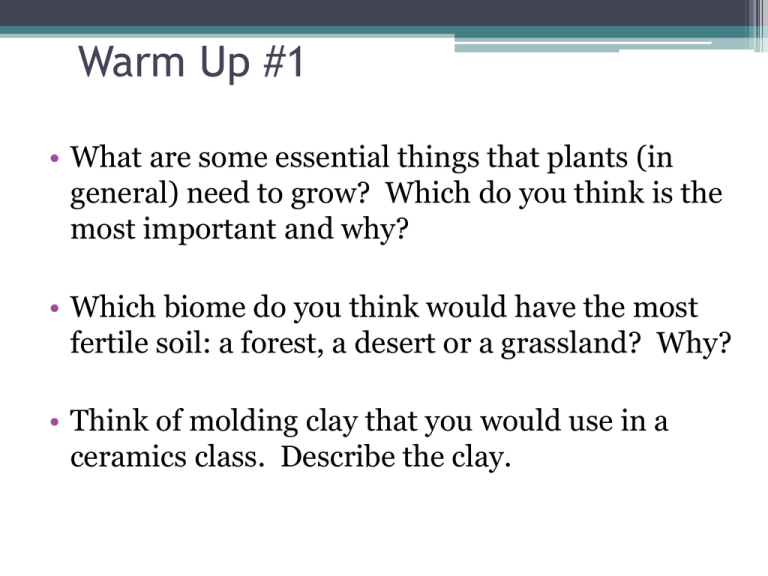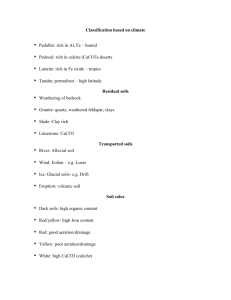File
advertisement

Warm Up #1 • What are some essential things that plants (in general) need to grow? Which do you think is the most important and why? • Which biome do you think would have the most fertile soil: a forest, a desert or a grassland? Why? • Think of molding clay that you would use in a ceramics class. Describe the clay. Soil • Clay – clumpy, sticky, tiniest particles ▫ Easily waterlogged • Sand – large particles, gritty sediment ▫ Plants needing little water • Silt – medium-sized particles, smooth ▫ Easily moved by water Components of Soil Soil Texture Triangle • O Horizon = surface ▫ Mostly decomposed matter ▫ THICK in deciduous forests Layers of Soil [Horizons] • A Horizon = topsoil (where stuff can grow) ▫ THICK in grasslands • B Horizon = subsoil ▫ Nutrient-rich, where roots end ▫ THICK in deserts • C Horizon = parent material ▫ Bedrock, no plant growth Soil & Biomes Revisited • Grasslands = THICK topsoil layer (fertile, nutrient-rich) ▫ Mostly loam and clay • Deserts = THICK subsoil layer (fertile for plants not needing H20) ▫ Mostly sand and clay • Most Forests [tropical, temperate, boreal] = acidic topsoil (nutrient-poor) ▫ Mostly clay, silt and loam How Soil is Made • Climate ▫ Precipitation and temperature of a region • Living Organisms ▫ Decomposers (putting nutrients in soil) • Topography (landscape) ▫ Hilly landscape = more erosion ▫ Elevation, wind exposure = other factors Soil Erosion • Erosion – movement of rock/soil from one place to another ▫ Wind, water, human activity • Result: desertification, less fertile soil, more acidic soil (rainforests) • Positive feedback loop • Sheet erosion – soil moves off as horizontal layer (strips of soil) Erosion Revisited • Erosion – moving from one place to another ▫ Wind and Water 3 Types • Sheet Erosion – thin layer taken off surface • Rill Erosion – water into soil & breaks down from inside • Gully Erosion – major rill erosion Effects of Erosion • US and Canada • Desertification – productive land desert ▫ Rainforests, China • Water contamination ▫ Algal Blooms ▫ Fertilizers/soil = less oxygen ▫ Mississippi River valley Case Study: Dust Bowl & Compost • Dust Bowl – Oklahoma, Texas Kansas (windy) ▫ Prairie plowing = soil erosion (topsoil gone) • Compost – recycled organic matter. ▫ Nutrient rich ▫ Restores soil ▫ Ex. egg shells, coffee grounds, veggies, paper Quick Quiz #1 • Draw the soil texture triangle, and decide where Sand, Silt, Clay and Loam are on the triangle • What are the 4 major “horizon” levels of soil? What is found at each level? • What is erosion, and what are the major effects of it on an area, giving one example. Warm Up #2 • Despite being almost lifeless, deserts have extremely fertile soil. Explain why this paradox exists, identifying the type of soil existing in this biome and why these conditions would produce more fertile soil. • Forests have nutrient poor soil due to a variety of factors. Identify and describe TWO of these factors, and provide one possible solution (anthropogenic or natural) to fix this problem. • What is composting? Describe this process and





